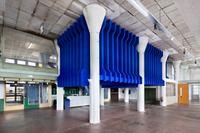Close Range is Het HEM’s residency that gives musicians and music researchers the opportunity to explore the depth of their practice through experimentation and interdisciplinary collaboration.
For the first edition, sound artists Thessa Torsing (aka upsammy), Nathan Marcus and Andreas Tegnander are collaborating on the project, “Sound as a Malleable Terrain” - an experimental artistic research project where the team explore ‘Het Hembrugterrein’ as an instrument.
Through research into the temporal patterns of the area and experiments with the materiality and sonic qualities of the terrain different ways of creating a living sonic terrain came into being. Inspired by Henri Levebre and his theory of ‘rhythm-analysis’ the group took walks into the depths of ‘Het Hembrugterrein’ and performed listening exercises. The artists synced and conversated with the space. Tuning-in their ears to the brushing of grass against a metal pipe, stones crumbling down a hill or a massive pile driver stomping its way through layers of soil. What is the sound of an environment being sculpted?
For archiving and naming the different types of rhythms the group used self-coined term RDM’s : Rhythm Distillation Methods. These methods are ways to extract rhythm from a certain place and/or time. Some of these methods are digital, others are analogue. In their research and composition both of these worlds are interacting and associating with one another. For example: compressing and stretching fieldrecordings to find hidden rhythms beyond common human temporality.
The RDM’s are used as the building blocks to create a new terrain where the visitors are invited to become sonic seismologists, to explore the rhythms and vibrations of the terrain. In the composition you hear the morphing of the terrain, traversing through time, both through human induced vibrations and the natural sculpting of the landscape: a constant motion of destruction and rebuilding. What would it sound like if you could record the crumbling of a building over time, or an ammunition factory turning into a creative hub? Seemingly still materials become actors, mimicking the birds who are orchestrated by the endless pounding of pile drivers.
A detailed diary of the research can be found here









